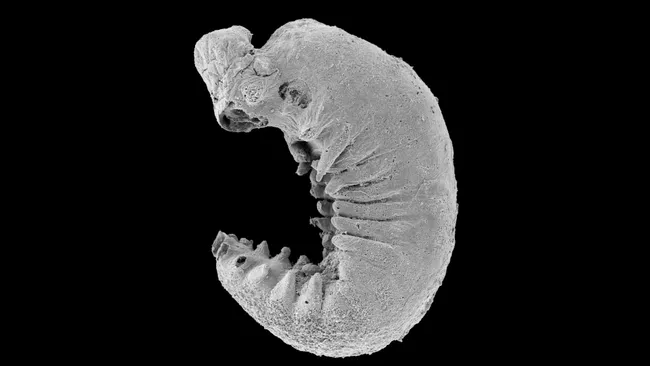The newly discovered Youti yuanshi larva fossil is so well-preserved that it provides a road map for arthropod evolution during the Cambrian period.
Researchers have unveiled key insights into the evolution of arthropod brains by examining the remains of a microscopic, worm-like creature that lived around half a billion years ago.
The fossil, belonging to a newly identified species named Youti yuanshi—with “yòutǐ” meaning “larva” and “yuánshǐ” meaning “primitive” in Chinese—was discovered in the Cambrian seas. This creature, which existed in its larval stage, was about the size of a grain of sand but is exceptionally well-preserved, providing unprecedented details on the development of complex arthropod brains.
Lead author Martin Smith, an associate professor of paleontology at Durham University in the U.K., expressed his excitement: “When I used to daydream about the one fossil I’d most like to discover, it was always an arthropod larva because developmental data are crucial for understanding their evolution. Given the tiny and fragile nature of larvae, I thought finding one fossilized was nearly impossible.”
The team recovered the fossil from the Yu’anshan rock formation in Yunnan Province, China, and used X-ray scanning to create virtual 3D images of its internal structures. These images revealed a brain and a primitive circulatory system, including traces of nerves connected to the larva’s simple legs and eyes.
Smith marveled at the preservation: “I knew this simple worm-like fossil was special, but seeing the intricate structures preserved under its skin was astonishing. How could these features have survived decay for half a billion years?”
Researchers are still uncertain why this fossil was so exceptionally preserved. They speculate that high phosphorus levels in the water soon after the creature’s death might have contributed to the preservation of its soft tissues, which were replaced with phosphate and embedded in rock.
The remarkable preservation allowed scientists to observe more of the early arthropod anatomy than usual, revealing that arthropod brains were becoming more complex during the time of Y. yuanshi. The larva had an ancestral brain region that would evolve into a more specialized arthropod head with antennae and other appendages, enabling diverse lifestyles and sophisticated predatory behaviors.
Smith noted, “As the arthropod brain evolved, it allowed for more complex behaviors and morphologies, leading to a rapid rise in diversity that continues to the present day.”
